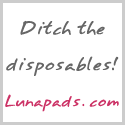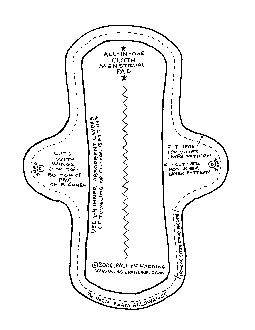Using the Babyville PUL fabric from Joanns.
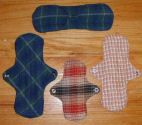
Um, Why?
I was in the mood for a quick sewing project that I could do with fabric I had on hand. I wanted to re-use the fabric to make something truely useful. While searching for tote bag ideas, I came across Jan Andrea's pad pattern, and thought I'd give it a try. To my surprise, I find using these for light days really comfortable and convenient. Who knew?!
This pattern is licensed under a Creative Commons License and is Copyrighted 2006 by Pauline Harding.
Other Cloth Menstrual Pad Patterns
FREE PATTERNS:
• Jan Andrea's page first got me inspired to make these pads, and the method I use is based on what she describes, though I've tweaked it to make a few things easier. She has a free all-in-one style pad pattern (recently updated to tessellate!), and lots of other cool sewing projects on her site. Thanks Jan!
• This Australian site has a wealth of information - free patterns in several sizes and styles, why's and how's of using them, a wide variety of useful links, etc.
• Hillbilly Housewife has a free envelope-style pattern, and some thoughts on using cloth.
• Tinybirdsorganics has a nice tutorial for an envelope-style pad that can be used alone or with inserts. Lots of pictures!
• Diapersewing.com has a very detailed free pattern and tutorial for sewing envelope-style pads. This pattern requires a serger.
• Many Moons has a free envelope-style pattern with tutorial, and some thoughts on adding a waterproof layer. This pattern requires a serger. They also sell organic flannel and ready-made pads.
• Craftster has a huge discussion thread about sewing and using cloth pads. There's another one at DiaperSwappers.
MORE FREE PATTERNS:
• WikiHowTo has a free pattern for an envelope-style pad.
• Health, home, and happiness has a tutorial for a pad with wings cut separately.
PATTERNS TO BUY:
• New Conceptions sells the Personal Things pattern which includes a number of styles (envelope, all-in-one, and even nursing pads for breastfeeding moms).
• The PrettyPads pattern is for an all-in-one style in several sizes.
• Kristin's Cloth Pads sells the Kristin's Cloth Pads pattern, which makes an envelope-style pad in several sizes.
• Candle on the Hill sells the KinderBeeTM pattern for an all-in-one style pad in several sizes.
Ready-Made Cloth Pads
• Luna Pads sells a wide variety of cloth pads and other supplies for your period. These folks have been in business for over ten years!
• Etsy, a great place to buy and sell handmade items, usually has a variety of ready-made cloth pads for sale, some of which look better than others.
• EBay also usually has a variety of cloth pads for sale. Again, look carefully for quality.
Feedback
This page has been getting over 1000 hits a month, from all around the world, and folks have been sewing these pads! I'm so thrilled to see my pattern being used! Here are a few examples. If you make some pads using this pattern, send me a pic and your comments and I'll post 'em:
--Sarah over at Saving in Cincinnati has a great pic of the lovely lavendar pads she made.
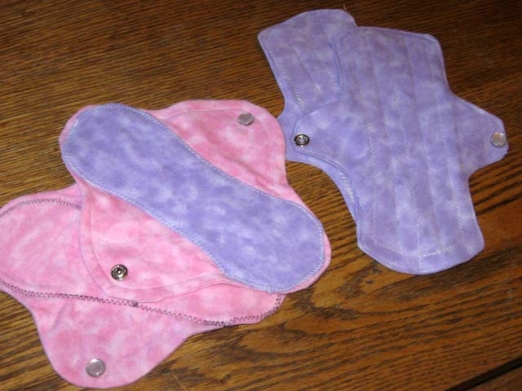
Helping Others
Several organizations donate cloth pads to girls in need. Why not hold a sewing party with some friends to make some?
~~~
This Web Page by Pauline Harding for Art Nurk, askpauline@comcast.net
All content, including text, photos, and pattern, are copyright 2007.
Contents may be copied for personal use if credit is given.
These washable cloth menstrual pads are quick and easy to make,
and very comfortable to use. Plus, they're cute! Use my free pattern!
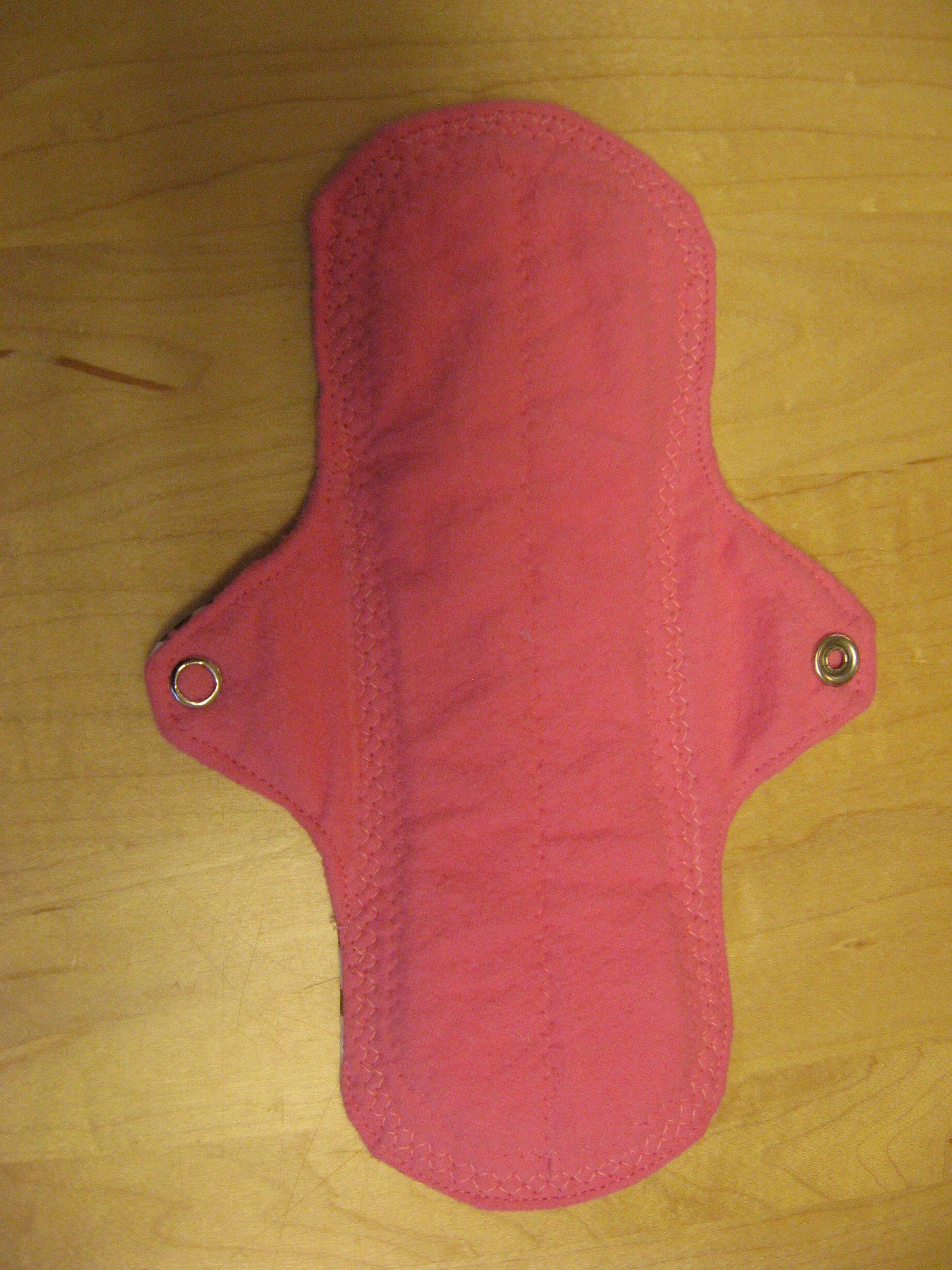
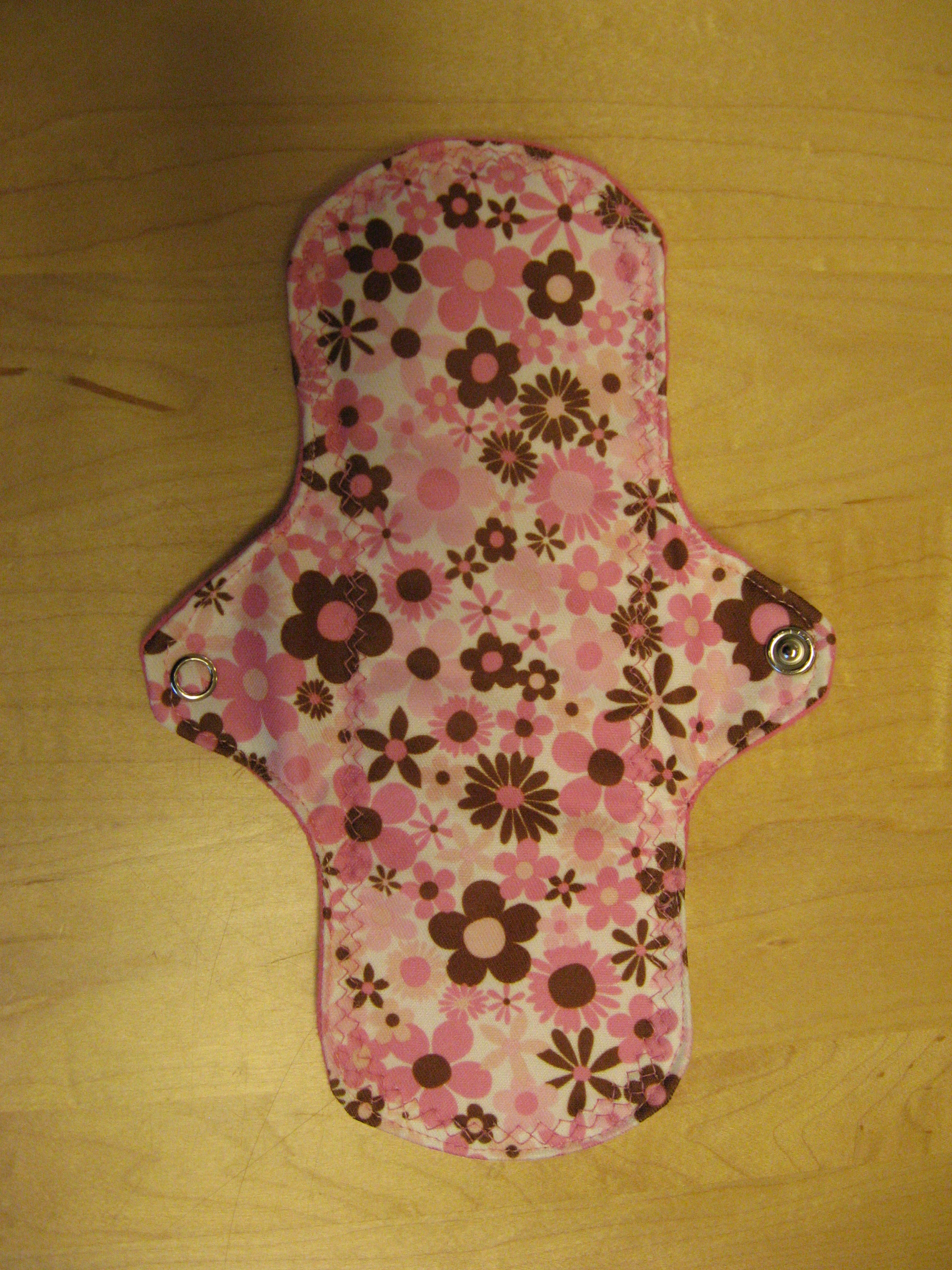
- Pauline's Pad Pattern - right click to save it to your computer, then print two copies. (This is a large file. If you have trouble with it, please email me and I'll try to solve the problem.)
- 100% Cotton Flannel or other soft absorbant fabric for the outer layers. I used pink flannel. You can also use an old flannel shirt or pj's. If you buy 3/8 yard, it is enough for about three pads. This fabric will be next to your skin, so choose something soft.
- 100% Cotton Batting for the inner layers. I used Warm & Natural. 3/8 yards will be enough for about three or four pads. You could also cut these pieces from a cotton hand or bath towel.
- Babyville PUL fabric. This line of fabric is sold at Joann Fabrics, and is promoted for making cloth diapers. It's what I've used for the pink pads on this page. You could also use a different waterproof or water-resistant fabric, if desired. There are many waterproof fabrics on the market, from nylon with a polyurethane coating, (often called PUL) to high-tech fabrics like Ultrex and Wind Pro fleece. The Green Pepper sells a variety of such fabrics and, while they don't have their fabrics on-line, they have a very informative catalog. The Rain Shed also stocks many high-tech waterproof fabrics.
- A snap fastener. I use one four-part snap. You can buy a pack of these, with a small attachment device included, at fabric stores. Don't bother with the snap pliers, they are expensive and do not work as well as using the small device and a hammer. (I have not used the plastic snaps; they seem more expensive and I've never had problems with the metal ones.) Or you could use a sew-on snap, hook-and-loop tape (VelcroTM), or a button and buttonhole. (I'm not a fan of Velcro, because it sticks to everything in the wash, and will probably wear out sooner than the rest of the pad. Some folks use the plastic snaps.
- Sewing machine. One that can do a zig-zag is best. If your machine does not do a zig-zag, then substitute a straight stitch where I call for a zig-zag. (For that matter, you could do this by hand if you really wanted to.)
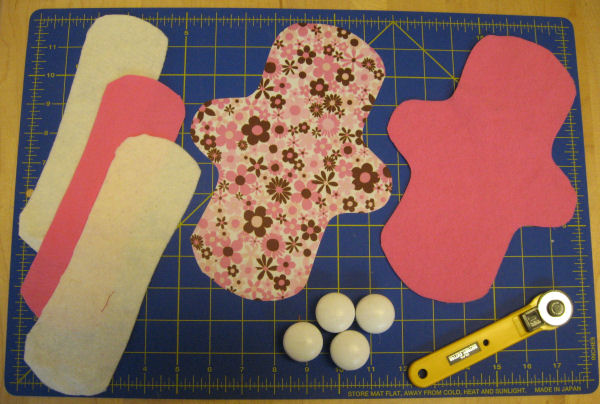
To make one pad:
~ Wash your flannel in hot water to pre-shrink it before sewing. I also like to wash the PUL in cold, just so that it is nice and fresh. I don't pre-shrink my batting, and it hasn't been a problem.
~ Take a look at the pattern picture - There are two pattern pieces - the outer layer, which has the wings, and the inner absorbent layer - sort of on top of each other on the same page. Print out two copies of the master pattern page, so you can cut the outer layer pattern from one and the inner layer pattern from the other.
~ Cut one large outer piece from the floral PUL fabric.
(If you are making more than one pad, you will be able to get more pieces from your fabric if you slant the pieces so they will nest, like the pink and floral pieces are positioned in the above picture. The PUL fabric can be cut off-grain without any problems.)
~ Cut one large outer piece from the pink flannel.
(This piece can also be slanted as above if you are cutting more than one.)
~ Cut one smaller inner piece from the pink flannel.
(This piece will not be seen in the finished pad. It is to cover the batting while it is going through the sewing machine, so it goes through more easily and doesn't get caught on the presser foot. Any plain cotton or other absorbant fabric can be used. It can be cut off-grain, at any angle.)
~ Cut two smaller inner pieces from the warm-and-natural batting.
(You can use more than two if you want a thicker pad, but two is a good choice for your first pad, as the sewing gets a bit harder with more.)
To cut my pieces, I use a small Olfa rotary cutter, and Olfa cutting board. When cutting, I hold my fabric down with some vintage pattern weights.
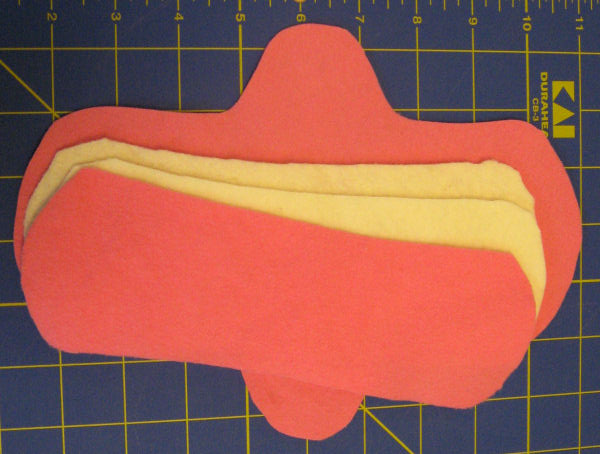
Sew the inner pieces to the large top piece. This will hold everything in place for the rest of the sewing. It also means the water resistant back piece doesn't get pierced by the channels sewn down the middle of the pad.
I stack the pieces - first, the pink flannel outer piece (right side down), then the two inner batting pieces, then the pink flannel inner piece. You don't need the large floral outer piece yet.
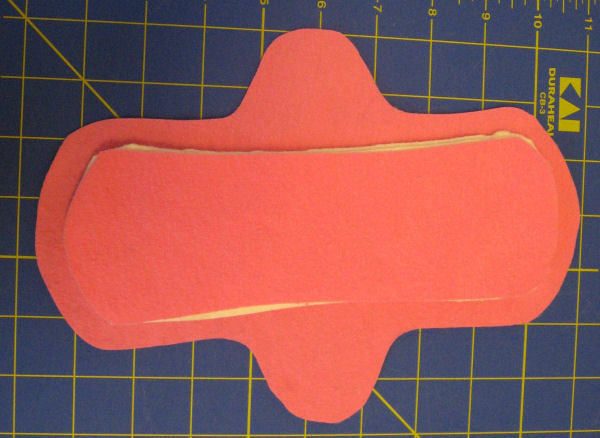
I line them up carefully, making sure there is a margin around the whole stack of inner pieces. I pin these together.
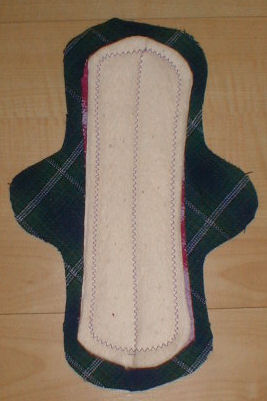
With the inner side facing up, as in the picture above, I first sew a medium zig-zag down the center of the stack. (The pic is of another version, in different fabric, but should give you the basic idea.) This line of stitching will channel fluds to the center of the pad, and help to minimize bunching. (I use the "2" zig-zag width on my machine, which is about half the maximum setting.) I hold both ends of the pad and pull it taut while it goes through the machine, so that the fabric does not "creep" as I sew. I do not pull the fabric through the machine, as that would bend the needle. Instead, I hold the fabric taut, and let the machine pull it through.
Once I've sewn the middle line of stitching, I continue all around the edge of the stack. It doesn't have to be right on the edge - in about 1/4" works well. The goal of this step is to anchor the edges of the inner stack to the outer piece to minimize bunching. It will also help the pad's wings to fold properly.
Once I am finished stitching, I flip it over, so the outer side is facing up. It looks like the picture below. This will be the top of the finished pad.
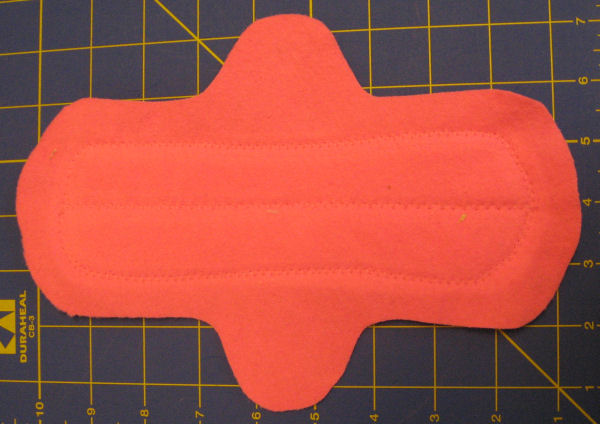
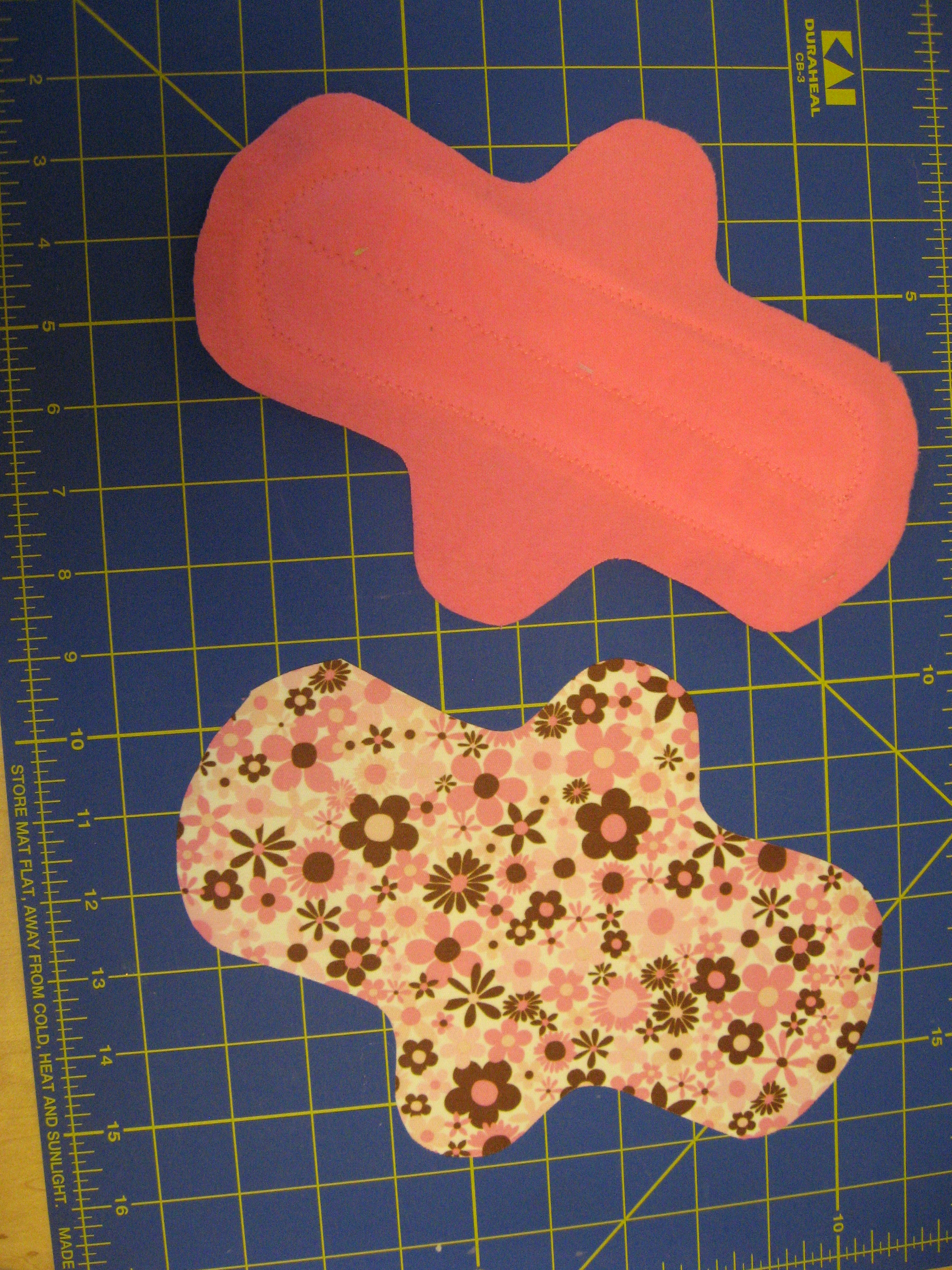
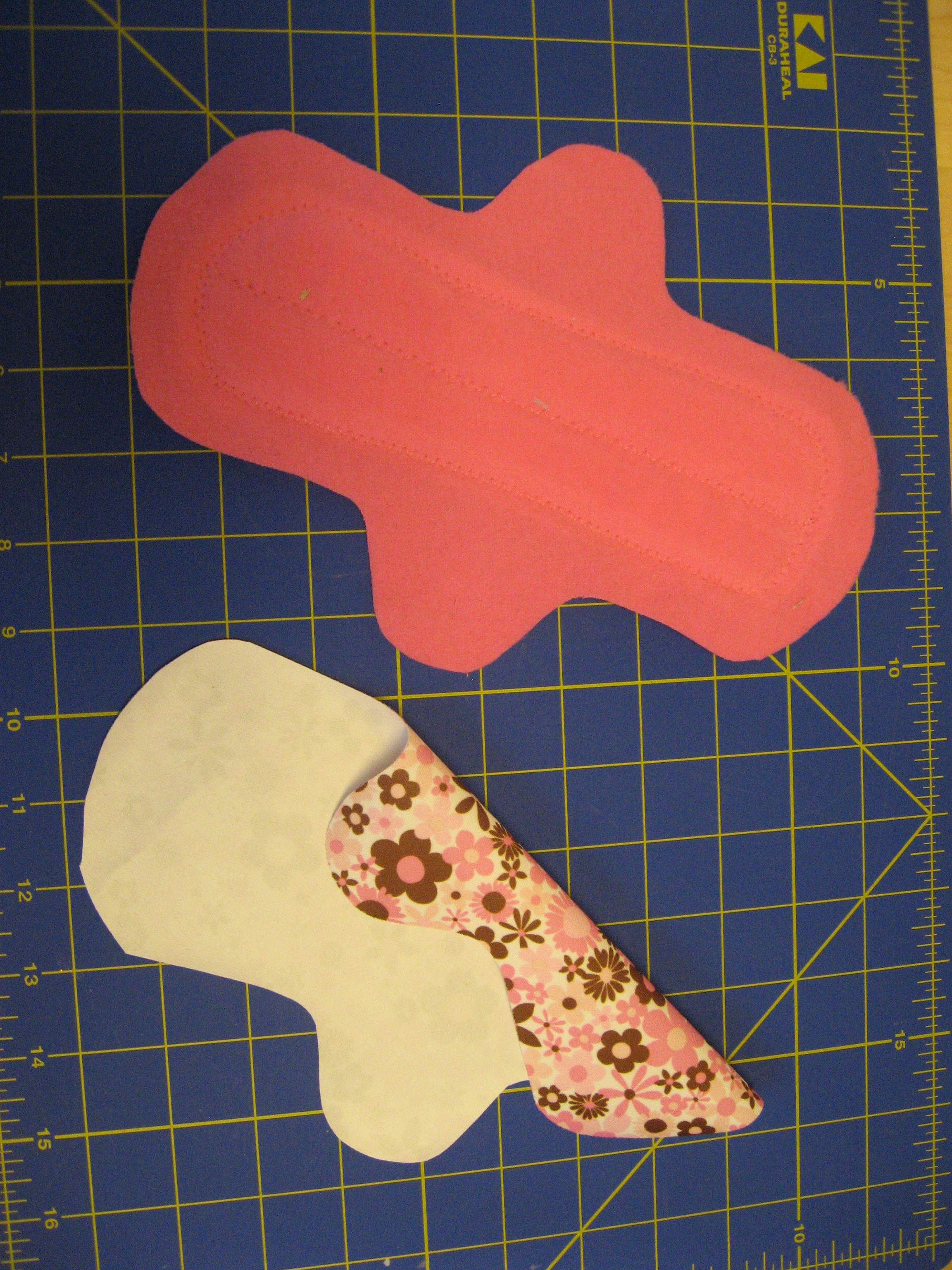
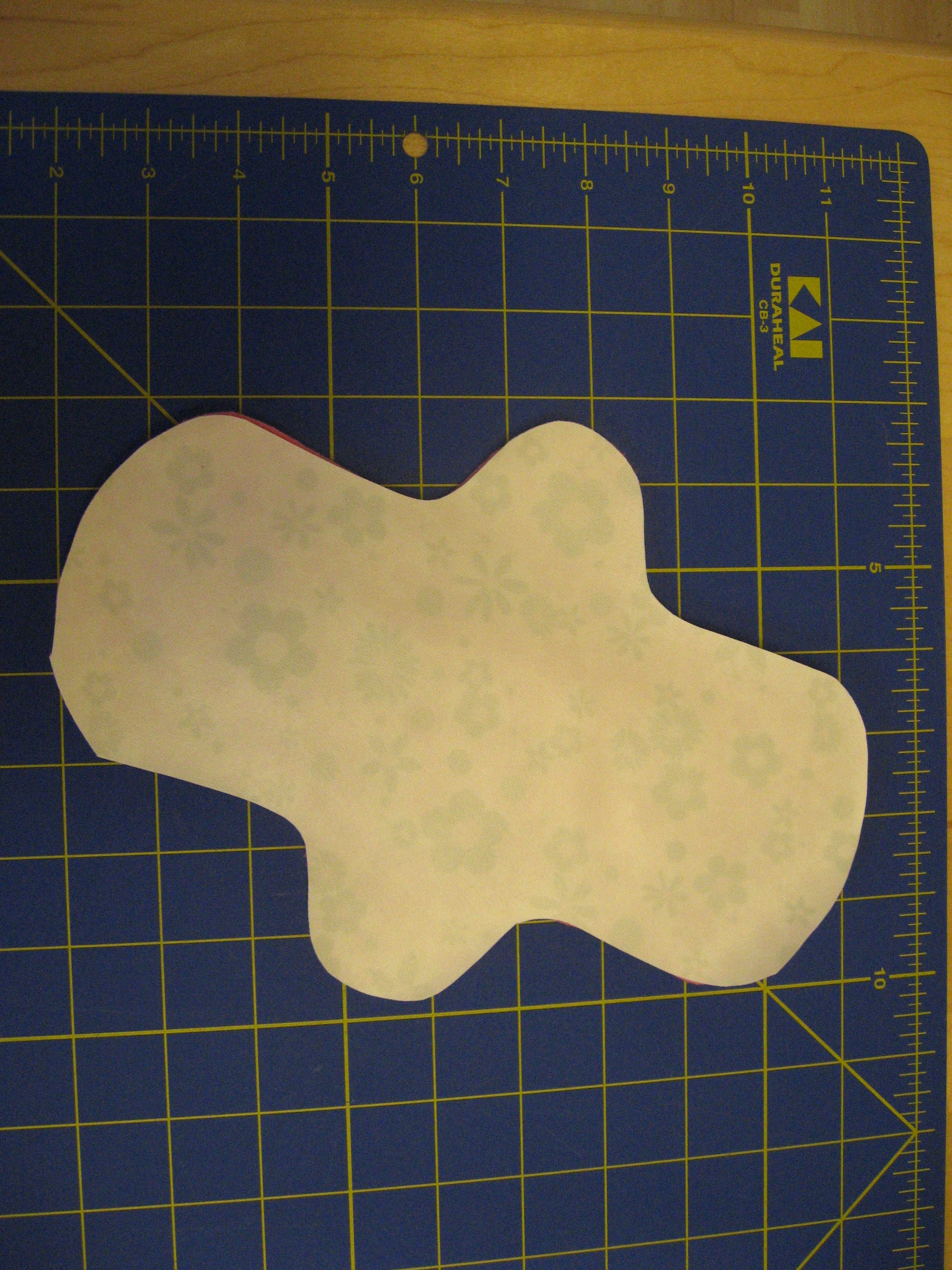
Now I get the floral PUL outer piece. I flip it over - the white side is the back. Then I place the floral PUL outer piece on top of the pink flannel outer piece, right sides together. (The right sides of the two outer pieces will be facing each other.) I pin the pieces together, putting the pins only in the seam allowance area so that I don't pierce a hole in the main part of the PUL.
Flip the pad over so the inner part is on top - it will be much easier to sew this way. I then sew around the edge, using a straight stitch and a 1/4" seam allowance. I leave a 2"section unsewn, for turning, preferably on the straight part of one side. It will look like the pictures below - the first picture is inner side up, the next is the outer side up.
There will be a gap of approximately 1/4" between your seam line and the inner pad - after turning, this space will be taken up with the thickness of the inner padding and the seam allowances. If you don't leave this space, it is really hard to turn the pad and keep all of the inner layers smooth.
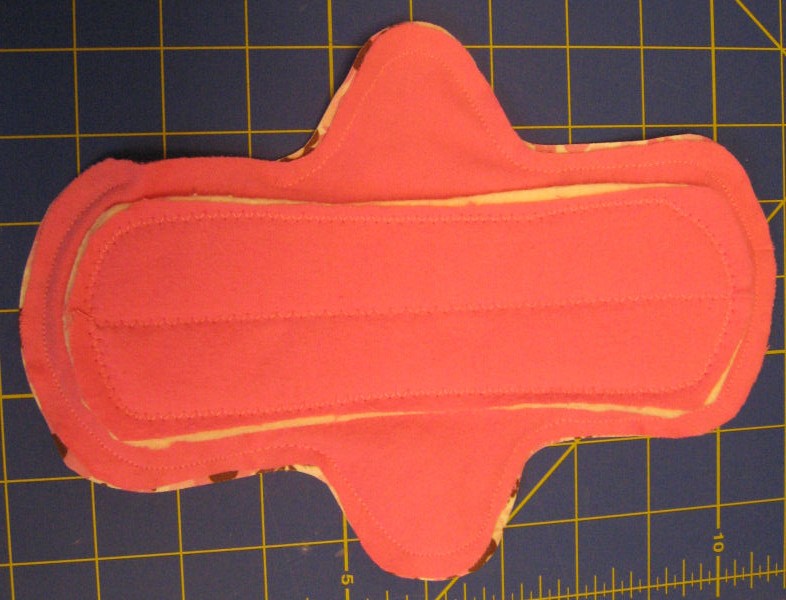
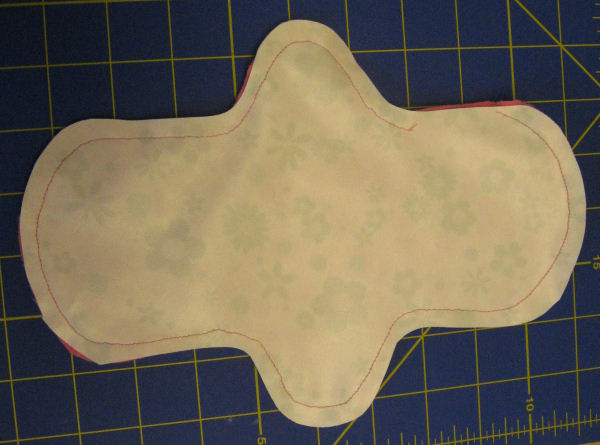
Now I carefully turn the pad right-side-out, though the opening I left in the side. If it doesn't turn well, I may un-turn it and trim a little bit off of some of the seam allowance, especially on the tight curves of the "wings" parts, then turn it right-side-out again. The turned pad looks like the picture below.
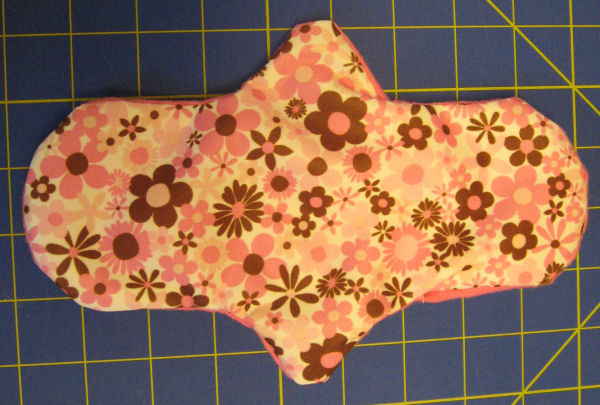
I straight stitch around the entire pad very close to the edge, which also closes the turning opening. I then apply a snap to each part of the wing. I double and triple check that I am putting the snap on the right way around before attaching it.


The floral part is water resistant and is the backing of the pad. The pink flannel is worn next to the skin. The wings fold back and snap to hold the pad to your undergarment. When not in use, the pad can be folded up and snapped, to put in your purse.
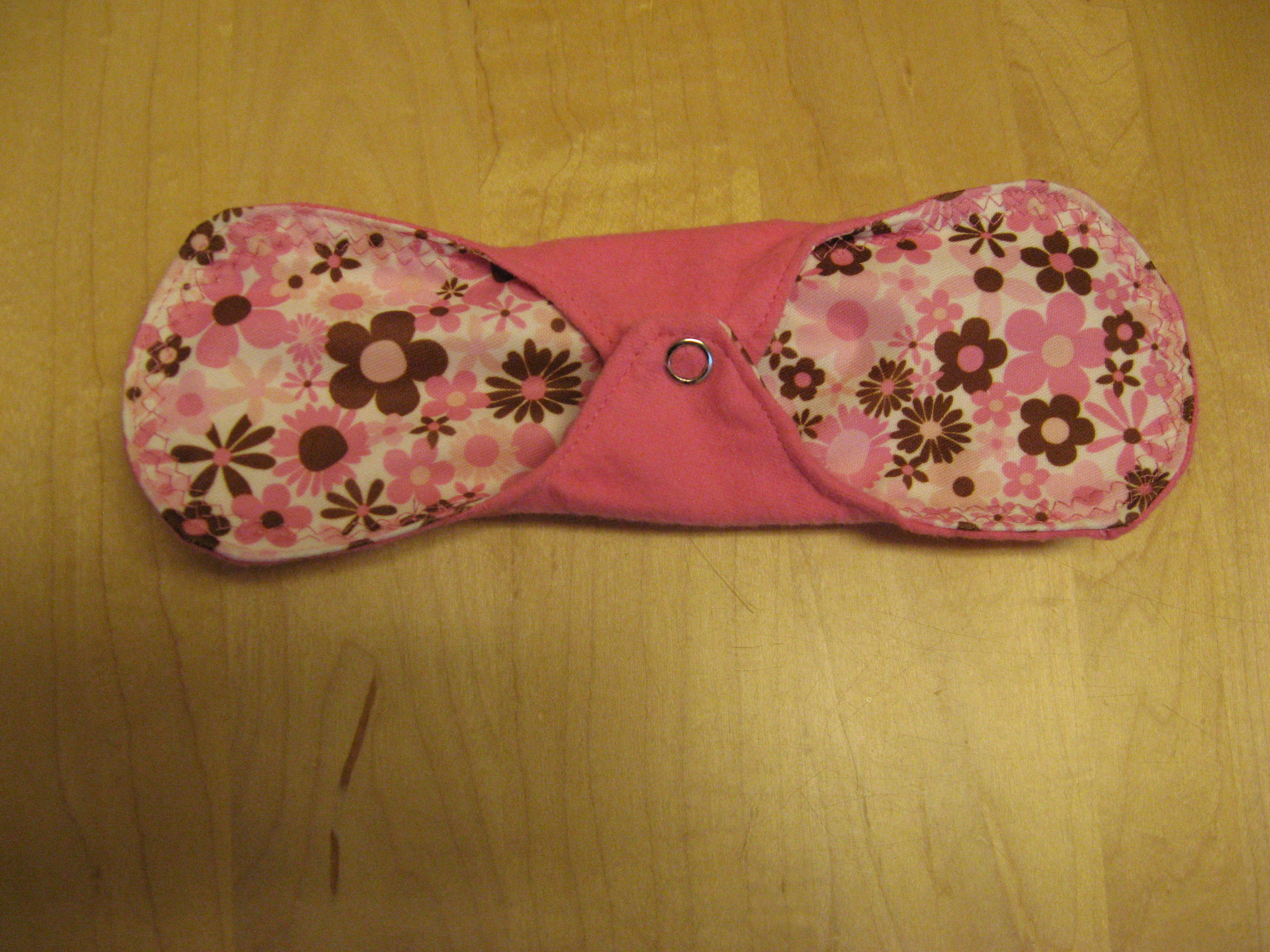
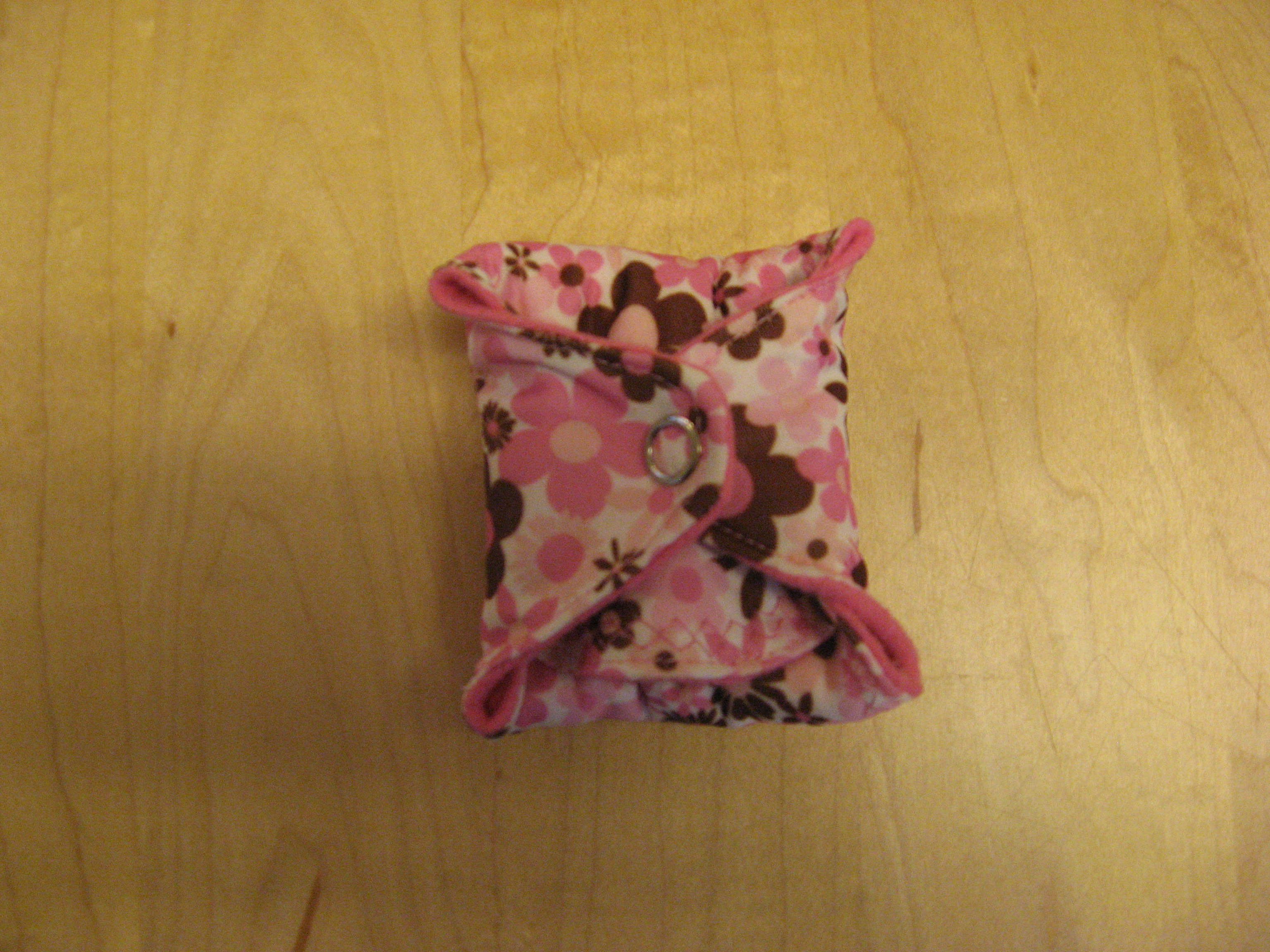
ABOUT SNAPS:
- I get my snaps at my local Joann's. I've also bought them at Nancy's Notions in Intercourse, PA., where they have a huge selection and they are very inexpensive - about twelve sets for a dollar.
- Four-part snaps are a bit tricky to put on. If you screw up, it can be very difficult to remove the snap. Take your time. Read the directions.
- I prefer the little tool that you use with a hammer over the pliers. The hammer method applies force all around at the same time, while the plier method is more uneven. (Plus, of course, you've got to buy the pliers.)
- If you're using the hammer method, protect your table with a thick magazine, otherwise you'll get a little round dent in the table from the snap ring.
- If you follow the directions carefully, you should be OK, but do a practice set on a scrap of fabric first.
- Make sure you're putting the working side of the snap where it should be. Notice on each side of these pads there is one snap half facing up and one facing down. Check and double-check.
- Make sure you know which is the snap side and which is the "attaches to the metal ring" side. Check to see if you're right by snapping the two parts together.
- Make sure all prongs on the ring side are protruding through the fabric before attempting to attach the snap side. This is critical. I work the fabric over the prongs with my fingers. The instructions tell you to use a pencil with an eraser to push down the fabric between the prongs - this helps quite a bit.
- Before you turn your pad, you might want to trim the seam allowances a bit on the ends of the wings, so that you are applying the snap to two layers of fabric rather than four.

